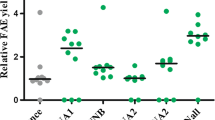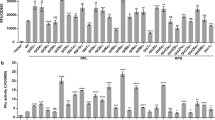Abstract
The gene encoding translation elongation factor 1-α from the yeast Pichia pastoris was cloned. The gene revealed an open reading frame of 1,380 bp with the potential to encode a polypeptide of 459 amino acids with a calculated mass of 50.1 kDa. The potential of the promoter (P TEF1) in P. pastoris was investigated with comparison to the glyceraldehyde-3-phosphate dehydrogenase promoter (P GAP) by using a bacterial lipase gene as a reporter gene. P TEF1 demonstrated a tighter growth-associated expression mode, improved functioning in the presence of high glucose concentrations, and promoter activities that yielded recombinant protein at levels similar to or in one case greater than P GAP. The sequence of the gene was deposited in GenBank under accession no. EF014948.




Similar content being viewed by others
References
Ahn JO, Choi ES, Lee HW, Hwang SH, Kim CS, Jang HW, Haam SJ, Jung JK (2004) Enhanced secretion of Bacillus stearothermophilus L1 lipase in Saccharomyces cerevisiae by translational fusion to cellulose-binding domain. Appl Microbiol Biotechnol 64:833–839
Arocho A, Chen B, Ladanyi M, Pan Q (2006) Validation of the 2-DeltaDeltaCt calculation as an alternate method of data analysis for quantitative PCR of BCR-ABL P210 transcripts. Diagn Mol Pathol 15:56–61
Axelos M, Bardet C, Liboz T, Thai ALV, Curie C, Lescure B (1989) The gene family encoding the Arabidopsis thaliana translation elongation factor EF-1α: molecular cloning, characterization and expression. Mol Gen Genet 219:106–112
Bieche I, Olivi M, Champeme MH, Vidaud D, Lidereau R, Vidaud M (1998) Novel approach to quantitative polymerase chain reaction using real-time detection: application to the detection of gene amplification in breast cancer. Int J Cancer 78:661–666
Cereghino GPL, Cereghino J, ILgen C, Cregg JM (2002) Production of recombinant proteins in fermentor cultures of the yeast Pichia pastoris. Curr Opin Biotechnol 13:329–332
Da Silva NA, Bailey JE (1991) Influence of plasmid origin and promoter strength in fermentations of recombinant yeast. Biotechnol Bioeng 37:318–324
Denis CL, Ferguson J, Young ET (1983) mRNA levels for fermentative alcohol dehydrogenase of Saccharomyces cerevisiae decrease upon growth on a non-fermentable carbon source. J Biol Chem 258:1165–1171
Doring F, Klapper M, Thesis S, Daniel H (1998) Use of the glyceraldehyde-3-phosphate dehydrogenase promoter for the production of functional mammalian membrane transport protein in the yeast Pichia pastoris. Biochem Biophys Res Commun 250:531–535
Doring F, Klapper M, Thesis S, Daniel H (2000) Production of functional mammalian membrane transport proteins in the yeast Pichia pastoris. In: Invitrogen Newsletter expressions 7.4, June 2000, Research News pGAPZ Pichia pastoris expression system
Heo JH, Hong KH, Cho EY, Kim MW, Kim JY, Kim CH, Rhee SK, Kang HA (2003) Properties of the Hansenula polymorpha-derived constitutive GAP promoter, assessed using an HSA reporter gene. FEMS Yeast Res 4:175–184
Kitamoto N, Matsui J, Kawai Y, Kato A, Yoshino S, Ohmiya K, Tsukagoshi N (1998) Utilization of the TEF1-α gene (TEF1) promoter for expression of polygalacturonase genes, pgaA and pgaB, in Aspergillus oryzae. Appl Microbiol Biotechnol 50:85–92
Kobayashi K, Kuwaes S, Ohya T (2000) Addition of oleic acid increases expression of recombinant human serum albumin by the AOX2 promoter in Pichia pastoris. J Biosci Bioeng 89:479–484
Koller A, Valesco J, Subramani S (2000) The CUP1 promoter of Saccharomyces cerevisiae is inducible by copper in Pichia pastoris. Yeast 16:651–656
Kozak M (1986) Point mutations define a sequence flanking the AUG initiator codon that modulates translation by eukaryotic ribosomes. Cell 44:292–293
Macauley-Patrick S, Fazenda ML, McNeil B, Harvey LM (2005) Heterologous protein production using the Pichia pastoris expression system. Yeast 22:249–270
Mumberg D, Müller R, Funk M (1995) Yeast vectors for the controlled expression of heterologous proteins in difference genetic backgrounds. Gene 156:119–122
Müller S, Thomas S, Peter KH, Henrik D (1998) Comparison of expression systems in the yeast Saccharomyces cerevisiae, Hansenula polymorpha, Kluyveromyces lactis, Schizosaccharomyces pombe and Yarrowia lipolytica. Cloning of two novel promoters from Yarrowia lipolytica. Yeast 14:1267–1283
Nakari-Setala T, Penttila ME (1995) Production of Trichoderma reesei cellulases on glucose containing media. Appl Environ Microbiol 61:3650–3655
Nakari T, Alatalo E, Penttila ME (1993) Isolation of Trichoderma reesei genes highly expressed on glucose-containing media: characterization of the TEF1 gene encoding translation elongation factor 1 alpha. Gene 136:313–318
Pal Y, Khushoo A, Mukherjee KJ (2005) Process optimization of constitutive human granulocyte-macrophage colony-stimulating factor (hGM-CSF) expression in Pichia pastoris fed-batch culture. Appl Microbiol Biotechnol 69(6):650–657
Resina D, Scorer C, Valero F, Ferrer P (2004) Expression of a Rhizopus oryzae lipase in Pichia pastoris under control of the nitrogen source-regulated formaldehyde dehydrogenase promoter. J Biotechnol 109:103–113
Romanos M, Scorer C, Sreekrishna K, Clare J (1998) The generation of multicopy recombinant strains. In: Higgins DR, Cregg JM (eds) Pichia protocols. Human Press, Totowa, NJ, USA, pp 55–72
Sambrook J, Russel DW (2001) Molecular cloning: a laboratory manual, 3rd edn. Cold Spring Harbor Laboratory, Cold Spring Harbor, NY, USA
Schmitt ME, Brown TA, Trumpower BL (1990) A rapid and simple method for preparation of RNA from Saccharomyces cerevisiae. Nucleic Acids Res 18:3091–3092
Sears IB, O’Connor J, Rossanese OW, Glick BS (1998) A versatile set of vectors for constitutive gene expression in Pichia pastoris. Yeast 14:783–790
Slobin LI (1980) The role of eukaryotic elongation factor Tu in protein synthesis. Eur J Biochem 110:555–563
Steiner S, Philippsen P (1994) Sequence and promoter analysis of the highly expressed TEF gene of the filamentous fungus Ashbya gossypii. MGG Mol Gen Genet 242:263–271
Triglia T (2000) Inverse PCR (IPCR) for obtaining promoter sequence. In: Tymms MJ (ed) Transcription factor protocols. Humana Press, Totowa, NJ, USA, pp 79–84
Tschopp JF, Brust PF, Cregg JM, Stillman CA, Gingeras TR (1987) Expression of the lacZ gene from two methanol-regulated promoters in Pichia pastoris. Nucleic Acids Res 15:3859–3876
Waterham HR, Digan ME, Koutz PJ, Lair SV, Cregg V (1997) Isolation of the Pichia pastoris glyceraldehyde-3-phophate dehydrogenase gene and regulation and use of its promoter. Gene 186:37–44
Wu JM, Chieng LL, Hsu TA, Lee CK (2003) Sequential expression of recombinant proteins and their separate recovery from a Pichia pastoris cultivation. Biochem Eng J 16:9–16
Acknowledgement
We are grateful to Philekorea Technology (Korea) for technical assistance with the real-time quantitative PCR method.
Author information
Authors and Affiliations
Corresponding author
Rights and permissions
About this article
Cite this article
Ahn, J., Hong, J., Lee, H. et al. Translation elongation factor 1-α gene from Pichia pastoris: molecular cloning, sequence, and use of its promoter. Appl Microbiol Biotechnol 74, 601–608 (2007). https://doi.org/10.1007/s00253-006-0698-6
Received:
Revised:
Accepted:
Published:
Issue Date:
DOI: https://doi.org/10.1007/s00253-006-0698-6




